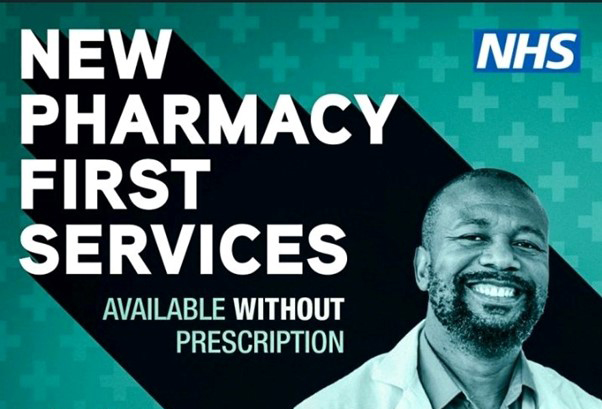Pharmacy First Services – Q&A

The new Pharmacy First Services in England enable community pharmacists to supply medicines, including antibiotics, for certain conditions without a prescription. The services have been carefully framed to ensure that uncomplicated cases can be treated safely and promptly and more complex cases can be referred to prescribers. The services will draw on pharmacists’ existing skills plus some additional training, effectively expanding the scope of their NHS work. This is expected to make better use of resources by saving up to 10 million appointments in general practice and provide opportunities for good antimicrobial stewardship.
Q – What is Pharmacy First and how does it work?
The NHS Pharmacy First Service enables community pharmacists to supply, if appropriate, certain pharmacy only ((P) and prescription only medicines (POM) via Clinical Protocol and Patient Group Directions (PGDs) for management of common infections. If medication is not necessary then self-care and safety-netting advice is offered. For example, a patient with a sore throat would not require an antibiotic if there is no evidence of bacterial infection (more than 80% of sore throats are caused by viral infections). Self-care advice would focus on symptomatic measures and ‘safety-netting’ refers to providing information about how to tell if the condition is getting worse and what to do.
Seven conditions are covered in the Pharmacy First Services – acute otitis media, impetigo, infected insect bites, shingles, sinusitis, sore throat and uncomplicated urinary tract infection.
The Pharmacy First Service also includes urgent medicine supply and minor illness referral but these two services are only available by referral. For the seven conditions covered by clinical pathways (listed above) patients can walk into a community pharmacy and self-refer.
Q – What is a Patient Group Direction (PGD)?
Patient group directions (PGDs) are written instructions to enable pharmacists to supply or administer medicines to patients, usually in planned circumstances. This can only be done if there is an advantage for the patient without compromising their safety.
A PGD is compiled and authorised by a multidisciplinary expert group – in this case the group includes the National Medical Director and the Chief Pharmaceutical Officer for NHS England. It specifies the clinical condition, the medicine, the types of patients that are included and excluded and the appropriate actions. It also specifies the competency required to be able to operate under the PGD. See this example for the supply of nitrofurantoin for the treatment of urinary tract infection. A separate PGD is required for each medicine. For example, for impetigo there are five separate PGDs covering hydrogen peroxide cream, fusidic acid cream, oral flucloxacillin, oral clarithromycin and oral erythromycin.
Q – What is the difference between a PGD and a clinical protocol?
A PGD relates to the supply of one specific medicine for a specific condition. A clinical protocol describes the management of a condition; it covers the steps to be taken to make a diagnosis, exclude other conditions, spot ‘red flags’, make appropriate referrals and then, if appropriate, provide treatment and advice. Thus, the clinical protocol will usually include more than one medicine. For example, the clinical protocol for impetigo includes first and second-line treatments for localised and widespread non-bullous impetigo. (See the clinical pathway for impetigo (source: NHS England – www.england.nhs.uk)
For the Pharmacy First service the clinical protocols have been set out as flow charts or clinical pathways. Each pathway includes a ‘gateway point’ at which the patient is potentially eligible for a supply of medicines under the PGD. Before reaching this point the pharmacist will have checked for serious complications or conditions that are outside the terms of the PGD. For example, in the case of impetigo, patients who have clinical features of impetigo but have recurrent impetigo or are less than one year old are outside the terms of the PGD and should be referred. (See the clinical pathway for impetigo (source: NHS England – www.england.nhs.uk)
Q – Do all pharmacies offer Pharmacy First Services?
More than 90% of community pharmacies in England have registered to provide the service.
Patients who are referred via NHS111 or other referring organisations will be offered a choice of pharmacies that are participating in the service at the time. If referred in this way then an electronic referral will be sent to the selected pharmacy – so staff will be expecting the patient.
Some local health bodies have issued leaflets listing participating pharmacies and doctors’ surgeries, such as this one from East Lancashire Clinical Commissioning Group:
Q – Can you self-refer or must you go through a GP or NHS 111?
Self-referral is possible for the seven conditions covered by the clinical pathways – acute otitis media, impetigo, infected insect bites, shingles, sinusitis, sore throat and uncomplicated urinary tract infection.
Q – Can you access the service remotely or do you have to attend in person?
Remote consultations are permitted for six of the conditions covered by the clinical pathways but for suspected otitis media attendance in person is required because the pharmacist will have to carry out an examination.
Q – Is there a charge for the service or the medication?
The appointment and advice from a pharmacist are free to access. When NHS medicines are supplied as part of this service, an NHS prescription charge per item should be collected, unless the patient is exempt from prescription charges.
Q – How will the service be evaluated?
A team comprising researchers led by London School of Hygiene and Tropical Medicine in collaboration with the University of Nottingham and Universities of Manchester and Oxford and experts at the UK Health Security Agency (UKHSA), has been awarded £2.4m by the National Institute for Health and Care Research (NIHR) to evaluate the new service. The research team will evaluate Pharmacy First’s take-up, safety, equity, cost-effectiveness and acceptability, as well as its implications for antibiotic use and antimicrobial resistance.





